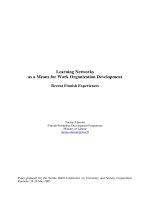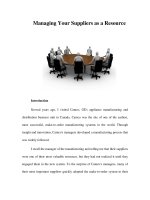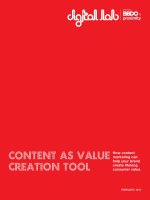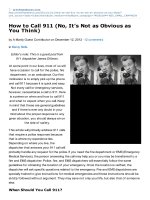F8Aa(Int)Mt2A as j08
Bạn đang xem bản rút gọn của tài liệu. Xem và tải ngay bản đầy đủ của tài liệu tại đây (191.43 KB, 9 trang )
Monitoring Test MT2A
Audit and Assurance
(International)
F8AA-MT2A-X08-A
Answers & Marking Scheme
The model answers to the questions are longer
and more detailed than would be expected from a
candidate in the examination. However, the model
answer may not include all valid points mentioned by
students – credit will be given to students mentioning
such points.
The model answer may be used as guide to the form
and standard of answer students should aim to
achieve.
Accountancy Tuition Centre Ltd
ATC
INTERNATIONAL
1
INTERNAL AND EXTERNAL AUDITORS
(a)
Fraud and error
Management and those charged with governance are responsible for the establishing
systems and controls to prevent and detect fraud and error.
An effective internal audit department can assist management in the risk
management of fraud and error through recommendations of appropriate internal
control and the appraisal and testing of such control.
The duties of internal auditors are generally determined by the organisation that has
set up the internal audit department and employs the internal auditors. Internal
auditors normally have a general responsibility to perform their work and their
reviews of systems with the possibility of fraud and error in mind.
This means that when they review the structure and operation of systems they have
regard to strengths in the system that will prevent or detect fraud and error and
weaknesses that will facilitate fraud and error.
When internal auditors discover structural or operational weaknesses that facilitate
or fail to prevent or detect fraud and error, they generally have a duty to report such
matters internally (e.g. to an audit committee).
The precise method of reporting varies from organisation to organisation. If internal
auditors discover actual instances of fraud or error, they also have a duty to report it.
It can be difficult in practice for internal auditors to deal with actual or suspected
management fraud. But the “Rules of Professional Conduct” do not permit auditors
to remain silent on the subject.
If an audit committee is established within the organisation, then they would be the
body to whom the internal auditor should report.
There is no general duty to report fraud or error outside the organisation and internal
auditors, like other employees, have a duty of confidentiality to the organisation
they work for.
In extreme circumstances however, it may be necessary for internal auditors to
report matters to persons outside the organisation (where money laundering is
discovered, for example).
External auditors are not, and cannot, be held responsible for the prevention and
detection of fraud and error – that is the responsibility of management.
External auditors plan and perform their work with an attitude of professional
scepticism. ISA 240 “Fraud and Error” states that the audit is designed to detect
material errors, which may be due to fraud or error, but this does not mean that the
audit can be guaranteed to detect material fraud or error.
The external auditor must consider the risk of material misstatement arising from
fraud and error when:
planning and performing audit procedures; and
evaluating and reporting on the results thereof.
Accountancy Tuition Centre (International Holdings) Ltd 2008
2
(b)
The external auditor should “plan and perform the audit with an attitude of
professional scepticism, recognizing that conditions or events may be found that
indicate that fraud or error may exist.”
As part of their planning procedures, the external auditor must discuss the
susceptibility of their client’s financial statements to material misstatement caused
by fraud.
Fraud or error should only be reported in the financial statements to shareholders if
they are material.
Like internal auditors, external auditors are bound by a duty of confidentiality to
their clients. However, in most countries, external auditors do have a number of
legal rights and duties to report certain types of suspected fraud, such as money
laundering, to certain bodies.
Internal audit’s role
(i)
Corporate governance
The objectives of good corporate governance include: the proper constitution of the
board, proper arrangements for the remuneration of directors, proper mechanisms
for shareholder relations, and proper accountability and audit.
Accountability and audit includes the maintenance of a proper system of internal
control. A proper system of internal control includes appropriate risk management
systems and overall organisational control.
Internal audit’s role in the context of these objectives includes assisting management
by suggesting ways in which these objectives can be achieved, and by monitoring
progress.
Example for manufacturing company
The internal auditors can recommend to the board those areas in which structural
changes need to be made in order to comply with codes of corporate governance,
such as those issued by the OECD and the World Bank. They can recommend
processes for setting objectives and targets, and for measuring their achievement.
(ii)
Risk management
Internal audit has a particular interest in investigating and evaluating the company’s
risk management structures. Internal audit can manage the provision of the basic
data which management can use in order to identify, prioritise and manage the risks
facing the company.
Internal audit can also help by developing models and techniques for identifying,
prioritising and managing risk.
Accountancy Tuition Centre (International Holdings) Ltd 2008
3
Example for manufacturing company
In a manufacturing company, risk management issues to be addressed include
operational, financial, health and safety and other regulatory issues. Internal audit
can help in identifying the issues, evaluating their importance and suggesting
mechanisms for managing or transferring the risk.
The management of risk depends on the business objectives, short and long term,
strategic and operational, and conflicts between objectives. These objectives
include, for example, the need to provide a return to investors, the need for longterm investment, and the need to produce a quality product. Internal audit can help
classify those risks.
(iii)
Organisational control
The simple existence of an internal audit function is an example of organisational
control. Internal audit can investigate and document existing control systems, as
well as test controls, and recommend improvements.
Example for manufacturing company
(c)
Internal audit can help in providing cost-benefit analyses in respect of the
implementation of control procedures, as well as making recommendations on
structural control.
When computer systems are designed, internal audit can ensure that the appropriate
development controls are implemented and tested.
Out-sourced internal audit issues
The issues to be considered include:
The costs of out-sourcing the function, including the internal administrative costs
and the costs of managing the function. These may be more or less than internal
costs, and a cost-benefit analysis will help establish the likely financial implications.
An out-sourced internal audit function will be more independent than an internal
function, but this has to be set off against the (probably) superior knowledge of the
business of the existing function.
Out-sourcing the internal audit function probably means a loss of control, whilst the
responsibility for the function will remain with the company.
Change management issues have to be addressed which can be time consuming and
expensive. Existing staff have to be re-deployed (perhaps to the company to which
the function is out-sourced) and there may be resentment of the new internal
auditors and deliberate attempts to frustrate them.
The choice of the out-sourcing company is important – it must have sufficient
resources and experience and there is always a risk associated with this; the contract
with the out-sourcing company will have to be carefully worded and the initial
contract should only be for a limited period of time.
Accountancy Tuition Centre (International Holdings) Ltd 2008
4
2
MICROPRODS
(a)
Evidence to check the cost of assembled laptops
(b)
Purchase invoices for component parts to confirm $600 element of cost.
Reperformance of client’s calculations (e.g. averaging of costs, stocksheet
extensions and overhead absorption rates) to verify their accuracy.
Payroll/timesheet analyses showing allocation/apportionment of production labour.
Classification/analysis of general ledger (G/L) expense accounts into production and
non-production overheads.
Calculations of overhead allocation, apportionment and absorption based on a
normal level of activity.
Production (quantity) records (budget and actual) to support calculations of
overhead absorption rates and any under/over absorption.
Evidence to ascertain the NRV of laptops
Audit working papers from year-end physical count identifying obsolete, damaged,
returned or otherwise slow-moving inventory.
After date selling prices, especially of laptops identified at year-end physical count
as returns/damaged etc.
Latest edition of computer magazine/buyers’ guide to assess market selling prices
and current state of industry.
Order book to ascertain whether advertising campaign has had any appreciable
effect on level of demand for notebooks.
Inventory turnover ratios, by model, to identify slow-moving and potentially
obsolete models.
Client’s records of sales returned identifying faulty inventory.
Serial numbers of a sample of year-end inventory items to estimate age by reference
to production records.
Client’s schedule (if any) comparing costs and NRVs of all obsolete, damaged or
otherwise slow-moving items.
Post year-end invoices/cash book payments supporting advertising campaign to
speed up movements of goods.
Accountancy Tuition Centre (International Holdings) Ltd 2008
5
(c)
Evidence to confirm the adequacy of the warranty provision
Tutorial note: When wok done under warranty work is costed, the accounting entries are:
Dr
Warranty expense
Cr Materials (replacement components etc.)
Cr Labour (+ overheads)
At the financial year end, management has to estimate a provision for warranty work to be
done in the future (therefore uncertain) in respect of sales already made.
Terms and conditions to identify circumstances which render the warranty
agreement void (e.g. negligent use disclaimers and servicing restrictions to
authorised personnel).
The client’s system for recording computers returned and authorising rectification
work under the terms of warranty.
A schedule of claims received (including those notified after the end of the reporting
period) identifying those rejected (e.g. due to breach of warranty conditions).
Rectification cost records and related general ledger accounts showing cost of
replacement components.
Payroll/timesheet analyses showing cost of service engineering labour.
Schedule of current year costs incurred under warranty agreements charged against
the warranty provision made in prior year.
Reperformance of client’s calculations (e.g. extrapolation of legitimate claims as a
percentage of sales) to confirm their accuracy.
Prior knowledge of management’s expertise in determining provisions (i.e. the
adequacy of provisions made in previous years based on the extent to which they
have been utilised.)
Correspondence with customers requesting work to be done under warranty or
identifying manufacturing defects.
Consumer reports in specialist magazines commenting on the reliability of the
client’s products.
Terms and conditions of notebook purchases from Far Eastern supplier (e.g. whether
any recourse or counter-claim provisions).
Physical condition of returned goods.
Repair invoices in respect of rectification work sub-contracted or referred to a local
agent (e.g. in respect of the notebooks).
Level of client’s insurance cover (e.g. in respect of defective product sales).
Accountancy Tuition Centre (International Holdings) Ltd 2008
6
3
PHOENIX
(1)
Trade investment
(2)
(i)
Matters
Assuming that Pegasus is insolvent (e.g. a receiver or liquidator has been appointed)
this is an adjusting event after the reporting period (IAS 10).
As the recoverable amount is likely to be $nil, a $80,000 impairment loss should be
recognised in the statement of comprehensive income for the year to 31 March (IAS
36).
As the likelihood of any distribution of the declared dividends is remote, the
$15,000 dividends receivable should be written off.
The total expense of $95,000 represents 5·6% of draft profit before tax and may be
material. Consideration should be given to whether or not it is material to the
statement of financial position.
Separate disclosure (IAS 1) may be appropriate to explaining Phoenix’s
performance for the year.
(ii)
Audit evidence
A copy of the press report.
The audited accounts of Pegasus for the year ended 30 September showing whether
there are assets with market values in excess of book values.
The receiver’s (or liquidator’s) statement of affairs indicating whether any
distribution is possible.
Written management representation confirming that there have been no events since
the end of the reporting period other than Pegasus’s insolvency.
Future maintenance
(i)
Matters
The accounting treatment of maintenance costs should be consistent with prior
years. However, IAS 37 does not permit the recognition of a provision that does not
meet the recognition criteria for liabilities.
Overhaul expenditure to restore or maintain the future economic benefits expected
from the plant and equipment should normally be recognised as an expense when it
is incurred (IAS16).
However, blast furnaces are of a type of plant and equipment that require relining
after a specified period. The components (blast furnace interiors) which require
replacement are separate assets that should be depreciated over the replacement
cycle. To the extent that the $500k includes the cost of replacing separate assets, it
represents future capital cost.
Accountancy Tuition Centre (International Holdings) Ltd 2008
7
Prudence does not permit the creation of hidden reserves and excessive provisions.
This “provision” does not therefore meet the IAS 37 definition:
(3)
there is no uncertainty about the timing (August);
there may be relatively little uncertainty about the amounts involved;
there is no liability as at 31 March.
This is the first time that the blast furnaces need this form of maintenance. IAS 37
has been in issue since 1999 and its requirements should be well understood
(ii)
Audit evidence
Discussion with senior management their reasons for having made the provision this
year (but not in previous years) and whether any costs have been contracted for to
identify any elements that cannot be escaped, e.g. cancellation clauses.
External tenders or quotes for sub-contracted work, again to identify any
cancellation clauses that may need to be provided for.
Rework from facts obtained of what auditor’s believe provision should be and
compare to client’s schedule showing make-up of provision.
Consider why management felt it necessary to establish this provision. Was it an
attempt to “profit smooth”? Is there any evidence of future material expenditure
which would have been offset against this provision?
Impact on audit opinion.
The trade investment write off ($80,000) represents 4.7% of profit before tax and
may be considered, on its own, as not being material. Add to that the connected
dividend of $15,000, then the overall impact becomes 5.6%.
Whilst both may still not be considered as material, it does seem odd for the
management to wish to carry an investment that would be disclosed in the notes
when that investment no longer exists.
Consideration should also be given to the status of the statement of financial
position position (facts not given). If this investment is material to that category,
then it should be adjusted. Should the client refuse to adjust, then the audit opinion
should be qualified “except for” on the basis of overstatement of an asset
(investment and receivable).
The provision represents 29% of draft profit before tax and is therefore material. If
the provision is not reversed the audit opinion should be qualified “except for” on
grounds of non-compliance with IAS 37.
Draft profit before tax ($1·7m) shows a 13% increase on the previous year. If
adjustments are made for points (1) and (2) , profit will be increased by at least
$400,000 (i.e. (1) $95k decrease plus (2) $500k increase). Profit before tax of
$2·1m would be a 40% increase on the prior year.
Accountancy Tuition Centre (International Holdings) Ltd 2008
8
Marking Scheme
For most questions the marking scheme suggests you award 1 mark a point. However, the mark you
award for each point will depend on its relevance and the depth of the student’s discussion. So, a brief
point may be worth 1/2 mark or less while a point with a longer and deeper discussion could be worth 2
marks.
Also, marks are not allocated to specific points, as the student may mention a valid point which is not
given in the model answer – obviously the student should be given credit for the point.
Many questions require the students to include a range of points in their answer, so an answer which
concentrates on one (or a few) points should normally be given a lower mark than one which considers
a range of points.
Marks
1
INTERNAL AND EXTERNAL AUDITORS
(a)
Generally 1 mark a point up to a maximum
(b)
1 mark a point to max of 2 marks for (i) and (ii) and max of 1 for (iii).
PLUS 1 mark for each example (1 example per element only)
(c)
1 mark per relevant point to a maximum of
7
max 8
5
__
20
––
2
MICROPRODS
(a)
Checking the cost of assembled laptops
Generally 1 mark a point up to a maximum of
4
Ascertaining NRV of computer inventory
Generally 1 mark a point up to a maximum of
4
(b)
(c)
Confirming adequacy of the warranty provision
Generally 1 mark a point up to a maximum of
7
____
15
––
3
PHOENIX
(a)
Matters
Generally 1 mark a point up to a maximum of 4 for each element
Audit evidence
Generally 1 mark a point up to a maximum of 4 per element
max 7
max 7
__
max 12
(b)
Opinion and circumstances
Generally 1 mark a point up to a maximum of
3
__
max 15
––
Accountancy Tuition Centre (International Holdings) Ltd 2008
9









